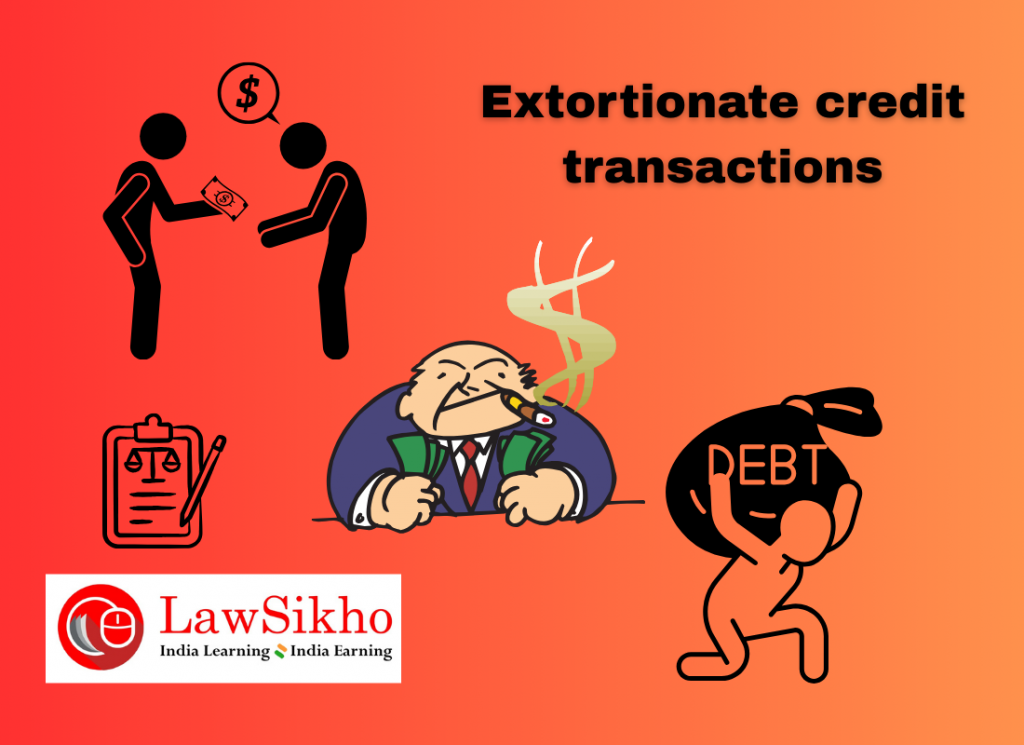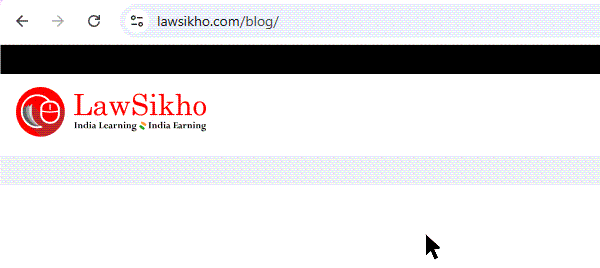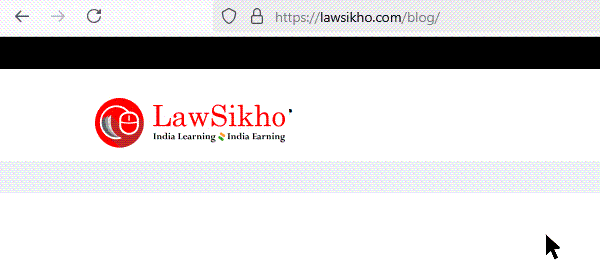Learn practical aspects of handling extortionate credit transactions under the Insolvency and Bankruptcy Code (IBC), including how to draft such an application for a refund of excess money or modification of arrangement, and how to contest them before the National Company Law Tribunal (NCLT). If you wish to build a practice in insolvency and bankruptcy law, this will be an invaluable guide.
Table of Contents
Introduction
Think of an exhausted traveller wandering through a vast desert, fatigued and desperate for water. Suddenly, at a distance, a freshwater pond appears. With some renewed hope, the traveller rushes forward, believing that his liberation is near. But as he reaches out to drink, reality sets in-it was just a mirage. The water was never there, and now he’s even further from survival than before.
Sounds cruel, right? But such is the nature of extortionate credit transactions.
To a company financially ailing and drowning financially, a lender offering immediate help seems like a mirage and a debtor looks at it hoping to recover and somehow sail through.
But you know what hides beneath the mirage? It is over-the-roof interest rates and brutal repayment clauses which are drafted to drown you further rather than rescue you.
What once seemed like liberation turns out to be an illusion, and the borrower feels more neck-deep in debt than before.
Now let us understand the concept of extortionate credit transactions with the help of a case law.
In the case of Shinhan Bank vs. Sungil India Pvt. Ltd. (2019 SCC OnLine NCLT 27094), Sungil India, a debt-ridden and financially struggling company, was disbursed loans on outrageous interest rates which were as high as 65% per annum. When insolvency proceedings commenced, the Resolution Professional (RP) raised concerns about extortionate credit transactions under section 50 of the Insolvency and Bankruptcy Code 2016 (“IBC”).
Considering the facts and circumstances of the case and the corporate debtor, NCLT revoked status of financial creditor. On appeal, the National Company Law Appellate Tribunal (NCLAT) upheld this decision, reiterating that excessively high interest rates are deemed unfair and are thus void under the IBC.
This case serves as a landmark judgment and also a reminder for the corporate debtor that not all financial assistance is genuine, sometimes, it’s just a mirage, leading companies further into a dark hole rather than pulling them out.
As a lawyer why should you know about this?
Lawyers who are keen on carving a niche in insolvency and bankruptcy matters must learn about this as it easily helps you fetch anywhere between 50k to 1.5L per draft (depending on your standing and number of years of practice). Tempting, isn’t it?
Let us cover the basics of the extortionate credit transactions first.
What is an extortionate credit transaction under the IBC?
Let’s take an example of a company, Cata Industries Pvt. Ltd. (“Cata” for short), which is in financial distress. Cata urgently needed funds to pay its employees and keep operations running. Banks and non-banking financial institutions refused to lend due to its poor creditworthiness. In desperation, Cata turned to Mr. XYZ, a private financer, who agreed to give a loan of Rs. 50 lakhs.
Don’t be relieved. This 50 lakhs came with a cost. To find that out, let’s read the clauses of the loan agreement:
- Interest Rate: 55% per month, far above the market rate of approximately 10–12%.
- Repayment Term: Irrespective of Cata’s financial position, the entire loan must be repaid within three months.
- Penalty Clause: If Cata misses even a single instalment, the lender has the right to seize the company’s assets at a pre-determined price.
- Additional Charges: A prepayment penalty of 15% applies, ensuring the lender still profits.
Due to the presence of these conditions, such transactions are termed extortionate credit transactions. And extortionate credit transactions under the IBC means that a lender is taking unfair advantage of a financially distressed borrower by imposing excessively high interest rates, unreasonable repayment terms, or severe penalties.
From the above example, you can see how what appears to be financial relief can actually push the borrower deeper into debt, making insolvency almost inevitable.
What is the legal framework of extortionate credit transactions?
Let us divide this into some questions.
What are the indicators of such a transaction under Regulation 5 of IBBI?
As per Regulation 5 of IBBI (Insolvency Resolution Process for Corporate Persons) Regulations, 2016, a transaction shall be considered extortionate where the terms:
- require the corporate debtor to make exorbitant payments in respect of the credit provided; or
As we have seen in the section right above, Cata had to pay interest at the rate of 55% per annum on the loan amount, which is way higher than the standard lending rate. This could be classified as an extortionate credit transaction.
- are unconscionable under the principles of law relating to contracts.
The terms of the loan agreement entered into between Cata and Mr. XYZ are one-sided and predatory. It was nothing but a desperate business call taken with the hope to revive the company and thus it can termed as unconscionable and the transaction can be classified as as an extortionate one.
Who can apply to the NCLT for a refund of excess payments?
As per section 50 of the IBC, the Resolution Professional or Liquidator can apply.
What is the lookback period in case of such transactions?
As per section 50(1) of the IBC, the lookback period is 2 years preceding the date of the insolvency commencement.
What are the reliefs that can be granted by the NCLT as per section 51?
- The NCLT can set aside or modify such transactions if they are found to be extortionate.
- It can order the return of excess benefits received by the creditor.
What are the exceptions to section 50 of the IBC?
When transactions involving financial services providers (like banks and NBFCs) under normal lending practices that is when they follow fair lending rates and industry regulations.
For instance, when a bank provides an education loan at the rate of 8% for a period of 20 years. This is fair, right? Nothing exorbitant or unfair.
What is the time limit to file an application for relief against extortionate credit transactions?
As per Regulation 35A of the IBBI (Insolvency Resolution Process for Corporate Persons) Regulations 2016, the timelines to make an application for relief against extortionate credit transactions are as follows:
- The resolution professional must, on or before the 75th day of the insolvency commencement date, assess whether the corporate debtor has engaged in an extortionate credit transaction;
- If the RP concludes that the corporate debtor has been involved in any such transaction, they must make a formal determination within 115 days from the date of insolvency commencement; and
- Following such a determination, the RP must make an application before the NCLT within 130 days from the date of insolvency commencement, seeking appropriate relief.
To sum it up, the resolution professional shall apply to the NCLT within 130 days from the date of insolvency commencement.
How to draft an application to reverse/avoid extortionate credit transactions?
Cata Industries Pvt. Ltd., a shoe manufacturing company, was struggling financially to pay money to its creditors including India Bank Ltd.
Given this, India Bank Ltd. filed an application to initiate CIRP against Cata Industries Pvt. Ltd. i.e. Corporate Debtor, which was admitted by the NCLT.
A Resolution Professional was appointed and accounts of the Corporate Debtor were audited. Certain transactions were flagged. Needless to say, such transactions were suspected to be extortionate credit transactions and hence the Resolution Professional (i.e. the Applicant) filed the interim application seeking necessary relief/s.
Now, let us move on to drafting. The rationale and explanation are in red.
The application shall begin with a cause title. As we are filing this application in a CIRP petition, this application must have the petition number of the CIRP.
BEFORE THE NATIONAL COMPANY LAW TRIBUNAL,
MUMBAI BENCH
I.A.NO. 54 OF 2025
IN
C.P. (IB) 1000/MB/2020
Thereafter, as the CIRP petition is the main one, state all the necessary and proper parties of it.
IN THE MATTER OF
India Bank Limited
…Financial Creditor
V/s
Cata Industries Pvt. Ltd.
…Corporate Debtor
Now here array the necessary and proper parties of this interim application. Do not miss out to implead the creditor from whom money was borrowed.
AND IN THE MATTER OF
S. Sankaran
Resolution Professional
Cata Industries Pvt. Ltd.
…Applicant
V/s
Suspended Directors of Corporate Debtor
- Mr. EFG
- Mr. ABC
- Mr. XYZ
4. Cata Industries Pvt. Ltd.
…Respondents
At the outset, it is crucial to mention the provisions under which this application is being filed.
APPLICATION BY RESOLUTION PROFESSIONAL UNDER SECTION 25(2)(J) AND 50 OF THE INSOLVENCY AND BANKRUPTCY CODE, 2016, SEEKING APPROPRIATE ORDERS AGAINST THE RESPONDENTS.
MOST RESPECTFULLY SHOWETH:
In the first paragraph, you need to convey in brief- who is the applicant? Provision under which is it filed? And the reason to file this application?
When it comes to giving a reason to file this application, you need to simply state your main prayer.
1. This instant application is filed by Mr. S. Sankaran, Resolution Professional under section 25(2)(j) and 50 of the IBC inter alia seeking appropriate orders against the Respondents requiring them to refund or adjust any excessive amounts charged from the Corporate Debtor under the provision of the IBC in the interest of the creditors of the Corporate Debtor.
Here, you need to talk about the financial document which forms the very basis of this application and most importantly, a provision that empowers you to approach the NCLT despite being a third party. State it clearly before your opponent raises a preliminary objection.
2. That a Transaction Audit was performed on the accounts of the Corporate Debtor at the instance of the Applicant. The Transaction Auditor in its Report dated 30th April 2024, has reported a transaction which in the opinion of the Applicant has casts serious doubts that the said transaction is extortionate in nature.
Therefore, the Applicant is making this Application in compliance with the statutory requirements as prescribed. Under section 25(2)(j) and 50 of the IBC read with relevant regulations framed there under to discharge the statutory duties and obligations as a Resolution Professional and to place on record, acts and conducts discovered to have been caused by erstwhile management of Corporate Debtor which has been detrimental to the interest of the creditors.
The facts and the circumstances leading to the instant application are more fully and particularly stated.
Unlike the regular audit, a transaction audit is specifically undertaken by the statutory auditors to identify avoidable transactions being- fraudulent, preferential and extortionate credit transactions.
PARTICULARS OF THE PETITIONER: –
Now in the next 4 sections, give the necessary details of the petitioner, the corporate debtor, the applicant and the Respondents, that is mainly its full name, legal status and registered address.
As we saw in the cause title above, this application arises out of a CIRP petition (or a liquidation application, depending on your case), thus it is important to convey to the authority how this application came to be filed that is vide an order of admission passed in the main petition.
3. India Bank Ltd., the Petitioner abovenamed, registered under the Banking Regulations Act, 1949 and having its registered office at One India Blues, Lower Parel, Mumbai- 400034 initiated the Corporate Insolvency Resolution Process (“CIRP” for short) of the Corporate Debtor, as filed before the Hon’ble Tribunal and was allowed on 15th December, 2023.
PARTICULARS OF THE CORPORATE DEBTOR: –
4. Cata Industries Pvt. Ltd., is a company registered under the Companies Act 1956 having its registered office at Plot No.B-10/B-11, Phase I, Kurla East, Mumbai- 400 102, is involved in the business of manufacturing and distribution of footwear.
PARTICULARS OF THE APPLICANT
Here you must also state the manner in which the Applicant was appointed that is vide an order of the NCLT and the majority decision taken by the Committee of Creditors.
5. The Applicant in the instant matter was appointed as the Resolution Professional by this Hon’ble Tribunal vide its order dated 7th February 2024 in IA No. 78 of 2024 in the captioned Petition, pursuant to the resolution passed with a majority vote in the 2nd Committee of Creditors (CoC) meeting held on 25th January 2024. His registered office is at Brilliant Insolvency Professionals LLP Suite-9B, 1st Floor, 22/28A, Andheri (East), Mumbai- 400 100.
PARTICULARS OF THE RESPONDENT
6. The Respondent No. 1 is the Corporate Debtor and is under CIRP. Respondent No. 2 and 3 are the suspended Board of Directors of Respondent No. 1. Respondent 4 is the private financier of the corporate debtor.
No one wants their application to get rejected on the basis of some preliminary objection, right? The NCLT needs to be convinced that it is the correct forum you have approached and that it has jurisdiction to adjudicate on the matter before it. Thus, you need to mention that the petition for CIRP was also admitted by this tribunal. Further, it also needs to be conveyed that the application is filed well within the limitation before it dives into the factual aspect. So, it is prudent to set things straight at the beginning.
JURISDICTION OF THE BENCH
7. The Applicant submits that the captioned company petition was filed before this Hon’ble Tribunal. By an order dated 15th December 2023 the above company petition was admitted was admitted by this Hon’ble Tribunal. Therefore, the subject matter of the present Interlocutory Application is within the jurisdiction of this Bench.
LIMITATION
8. The Applicant declares that there is no period of limitation prescribed for the instant application as known to the Applicant. However, the application is within the period of limitation, if any.
BRIEF FACTS
Now it is time to state the facts of the matter in chronological order.
Your initial few paragraphs must deal with the CIRP proceedings that is it must state how the petition came to be filed, an interim resolution professional was appointed, the moratorium was declared and public notice was issued as per the provisions of the IBC.
9. The CIRP of the Corporate Debtor has been admitted by this Hon’ble Tribunal vide order dated 15th December 2023 in C.P. (IB) 1000/MB/2020 filed under section 7 of the IBC. Pursuant to such admission vide the order dated 15th December 2023, the moratorium was imposed and Interim Resolutional Professional Mr. S. Sankaran was appointed in relation to the above proceedings. Hereto annexed and marked as Exhibit-A is the copy of the order.
10. The aforesaid order dared 15th December 2023 came to the knowledge of the Applicant and thereafter, he issued a Public Notice in terms of the IBBI (Insolvency Resolution Process for Corporate Persons) Regulations, 2016 in the national edition of Free Press Journal (English Edition) and Navshakti (Marathi edition), inviting submission of claims from the creditors of the Corporate Debtor. Pursuant to such a Public Announcement made on behalf of the Corporate Debtor, various claims have been received and a CoC is also formed.
Here, you need to briefly explain how the Applicant’s appointment was confirmed and was appointed as the resolution professional and the role of CoC in it.
11. The Applicant states that in the 2nd CoC meeting held on 25th January 2024, a resolution was passed for the appointment of the Applicant as the Resolution Professional. Accordingly, the Interlocutory Application being IA No. 23 of 2024 came to be filed before this Hon’ble Tribunal on 1st February 2024 for the confirmation of the appointment of the Applicant as the Resolution Professional to conduct CIRP of the Corporate Debtor.
Upon hearing of the abovementioned, this Tribunal was pleased to confirm the appointment of Applicant as the resolution professional vide its order dated 8th February 2024. Hereto annexed and marked as “Exhibit-B” is the copy of the said order dated 8th February 2024.
Let us assume here that the Respondent Nos. 2 and 3 failed to extend any co-operation and provide documents requested by the Applicant. What action do you think the Applicant would have taken against such Respondents? In the next paragraph, we shall be dealing with this.
12. The Applicant states that, when the Applicant was an IRP, he took steps as required under the IBC and sought necessary documents and information from the suspended directors. However, due to the unavailability of documents and non-cooperation of the suspended directors, the IRP filed an interlocutory application being IA No. 156 of 2024 on 15th March 2024 under section 19(2) of the IBC interalia seeking directions to the suspended directors to provide all the relevant information relating to the Corporate Debtor.
The Applicant submits that due to the lack of relevant information with regard to the business of the Corporate Debtor, CIRP could not be conducted effectively. The Applicant however states that the suspended directors have now cooperated and the said IA has been disposed of.
Once you are appointed as the resolution professional, your first step shall be to conduct a transaction audit to determine if there are any or if there were any avoidable transactions taken/taking place.
So in the next few paragraphs, you need to add the necessary details of the audit report which gives a clear picture and confirms that an extortionate credit transaction has taken place. So mention that an audit was conducted of the Corporate Debtor’s books and that the auditor flagged certain transactions which, prima facie appear to be extortionate.
The following paragraphs will mention the fact that an auditor was duly appointed to conduct the audit of the corporate debtor and that the auditor, after completion of the review, submitted a final report to the Applicant, which should also have identified extortionate credit transactions.
13. The Applicant engaged Shah & Doshi Chartered Accountants as the Transaction Auditor vide its letter dated 17th April 2024 to conduct a Transaction Audit of the Corporate Debtor for a review period from 1st April 2023 to 5th May 2024 and to determine the transactions of the nature mentioned under sections 25 (2)(j), 43, 45, 49, 50 and 66 of the IBC.
14. That on 17th April 2024, the Transaction Auditor was appointed to conduct the Transaction Audit and submitted its Final report to the Applicant on 29th June 2024 having considered the transaction report as determined and specified transactions that were extortionist in nature. Hereto annexed and marked as “Annexure 2” is the copy of the Transaction Report dated 29th April 2022, along with its Annexures. Hereto annexed and marked as “Annexure 3” is the copy of the Financial Statement for the Financial year 2022-2023 and “Annexure 4” is the copy of the Financial Statement for the Financial year 2023-2024.
Here we need to give reasons as to why should NCLT pass necessary orders in our favour and thus, in the following paragraphs, we shall state why such an application should be filed to uphold objects of the IBC and the amount siphoned off by the Respondents
15. That in view of the determination of transactions by the Resolution Professional, this instant Application is being filed to bring to the notice of the Hon’ble Tribunal, that the transaction is extortionist in nature so that appropriate orders may be passed for the avoidance of such transactions and to set it aside and reverse its effect.
16. The Applicant submits that the object of the IBC and this present application inter alia is to ensure that all the creditors get their dues in an equitable manner which otherwise has been wrongfully dissipated on account of extortionist credit transaction.
17. The Applicant submits that monies siphoned off under extortionate credit transactions of Rs. 1,50,00,000/- (Rupees One crore fifty lakhs only) are being prayed to be be refunded to the Corporate Debtor together with interest.
In the next paragraph, you need to state the provisions of the IBC which form the basis of this application and give a flow to the application.
Relevant provisions from the Code
“50. Extortionate credit transactions.
(1) Where the corporate debtor has been a party to an extortionate credit transaction involving the receipt of financial or operational debt during the period within two years preceding the insolvency commencement date, the liquidator or the resolution professional as the case may be, may make an application for avoidance of such transaction to the Adjudicating Authority if the terms of such transaction required exorbitant payments to be made by the corporate debtor.
(2) The Board may specify the circumstances in which a transactions which shall be covered under sub-section (1).
Explanation.—For the purpose of this section, it is clarified that any debt extended by any person providing financial services which is in compliance with any law for the time being in force in relation to such debt shall in no event be considered as an extortionate credit transaction. “
From now on, we shall be talking about the loan agreement which is predatory and extortionist in nature. We shall also be producing relevant clauses/extracts from the said loan agreement, which will strengthen our case.
18. The Applicant states that since 2021, Respondent No. 1 has been in an extremely financially unstable situation so much so that it was facing extreme difficulties in even paying salaries to its employees. To top it all, all the banks and financial institutions were also refusing to lend money to Respondent No. 1 due to its low creditworthiness.
19. The Applicant further states that owing to the aforementioned circumstances, the Respondent took advantage of the Applicant’s financial distress and lack of bargaining power. Considering the position that it was in, the Corporate Debtor readily accepted its terms and conditions. Pursuant to this, a loan agreement dated 30th September 2023 was executed. Vide this agreement, Respondent No. 4 agreed to lend a sum of Rs. 4,00,00,000/- at an interest rate of 55% per annum to Respondent No. 1.
20. The terms of the credit transaction were harsh, unconscionable and contrary to fair business practices. Below are some of the clauses indicating the oppressive nature of the said loan agreement for the ready reference-
“2. INTEREST RATE AND PAYMENT TERMS
Interest Rate: The Borrower agrees to pay an interest rate of 55% per annum, compounded weekly.
2.2 Payment Schedule: Payments shall be made monthly in the amount of Rs. 34,00,000/- , with the final payment including all outstanding principal and interest due on 15th October 2024.
2.3 Late Payment Penalty: Any missed payment shall incur an additional penalty of 7% per day compounded daily.
4. DEFAULT TERMS
4.1 The Borrower shall be in default if:
- A single payment is late by 48 hours.
- The Borrower fails to provide additional security upon demand.
- The Borrower attempts to challenge this Agreement legally.
4.2 Upon default, the Lender shall have the right to:
- Demand immediate full repayment of the outstanding amount, including future interest.
- Confiscate collateral without judicial process.
- Charge a penalty of 50% of the loan amount for inconvenience.
- Pursue legal action, with all legal fees and expenses borne by the Borrower.
5. WAIVER OF RIGHTS
5.1 The Borrower waives all rights to dispute the terms of this Agreement, including interest rates, penalties, and enforcement actions.
5.2 The Borrower expressly agrees not to seek relief under any consumer protection or bankruptcy laws.
5.3 The Borrower consents to immediate enforcement without prior notice or court intervention.”
21. In view of the aforesaid clause, the Applicant submits that the continuation of this agreement would lead to severe financial hardship for the Applicant and unjust enrichment for Respondent No.1.
Now, you need to substantiate your case with the help of the bank statements of Respondent No.1 which show repayments made periodically to Respondent No. 4.
22. The Applicant is also stating a table below depicting debits to the Respondent No. 4-
| Date | Particulars of the transaction | Amount |
| 31st December 2023 | Interest payment | Rs. 30,00,000/- |
| 31st March 2024 | Interest payment | Rs. 30,00,000/- |
| 31st May 2024 | Interest payment | Rs. 30,00,000/- |
| 30 September 2024 | Interest payment | Rs. 30,00,000/- |
| 31st December 2024 | Interest payment | Rs. 20,00,000/- |
| Total | Rs. 1.5 crore | |
In the next part, we need to reiterate how the aforesaid transactions adversely affect the rights of the creditors and thus must be classified as extortionate credit transactions as per the provisions of the IBC.
22. The Applicant submits that from the above it can be established that the Corporate Debtor through the Respondents have entered into extortionate credit transactions thereby prejudicially affecting the rights and interest of the Lender/Financial Creditor of the Corporate Debtor and that the same is clearly liable under section 50 of the IBC.
General averments required to prove your bonafide shall also be added.
23. It is a fit and proper case where the necessary direction is issued and action is taken in accordance with the law.
24. This Application is made bonafide and for the ends of justice.
25. The balance of convenience and the prima facie case is in favour of order as prayed for herein
Prayers
In this application, before we ask for compensation or any other relief, we need to seek a declaration to the effect that this transaction be held extortionate. Once the NCLT has granted such a declaration, refund and other reliefs as stated below shall follow.
26. The Applicant humbly prays before the Hon’ble Tribunal for the following reliefs:
a) That this Hon’ble Tribunal may be pleased to adjudicate the facts and circumstances of this case and be pleased to declare the various transactions carried out by the Corporate Debtor as extortionate credit transactions as per section 50 of the IBC particularly;
b) That this Hon’ble Court may be pleased to make necessary adjudication in the facts and circumstances of this case and necessary directions be passed in terms of sections 50 and 60 (5) (c) of the IBC;
c) That this Hon’ble Court be pleaded to set aside the loan agreement dated 30th September 2023.
d) That this Hon’ble Tribunal may be pleased to take in its notes the report of the Transaction Auditor which is being placed before this Hon’ble Tribunal by the Applicant in the instant case.
e) Be pleased to order Respondent No. 4 to refund any excessive amount to the tune of Rs. 1.5 crore paid under the transaction.
f) Report the transactions to the Insolvency & Bankruptcy Board of India for making a complaint to the Special Court under section 236 of the IBC.
g) Such further or other orders as this Hon’ble Tribunal may deem fit and proper in accordance with the Civil Procedure Code and the Code of Criminal Procedure.
h) Any other such directions which this Hon’ble Tribunal may deem fit.
Lastly, it is important to convey to the NCLT that the prescribed court fee is paid by the applicant. Hence, an averment to this effect is mandatory.
Particulars of the Bank draft evidencing payment of the fee for the petition or application made:
Branch of the Bank on which drawn:
Name of the issuing branch:
Demand Draft No. [insert DD No.] Date [insert the date on which DD was drawn]
(Note: If payment has been made via Bharatkosh, you need to mention the transaction ID and date of such a transaction)
Amount Rs. 1000/-
Mr. S. Shankaran
Resolution Professional
Cata Industries Pvt. Ltd.
Mumbai, dated this 5th day of April 2024
To show the Applicant’s bonafide, the resolution professional must depose to the effect that what he knows and has averred in the application, is true.
VERIFICATION
I, Mr. S. Shankaran, age 45, Indian Inhabitant, the Resolution Professional of Cata Industries Pvt. Ltd. having his registered office at Brilliant Insolvency Professionals LLP, 46-B, 5th Floor, Ghatkopar (east), Mumbai do hereby state and declare that whatever has been stated in the foregoing paragraphs are true to the best of my knowledge and belief and I believe the same to be true.
Solemnly declared at Mumbai
)
On this _____ day of June, 2025
)
Sd/-
Deponent
Sd/-
Advocate for Deponent
How to contest the application before the NCLT?
How does the Applicant contest?
- It starts with filing an application before the NCLT.
- Proves that the transaction was extortionist by placing reliance on the loan agreement that lays down harsh conditions of repayment, bank statements & financial records, market reports, etc.
How does the Respondent contest?
- He will first file a detailed reply denying all the allegations made by the Applicant in the Application.
- Argues that the transaction was genuine and lawful and that the directors gave their express consent at the time of entering into such an agreement, give a commercial justification by showing that it was a risky transaction to enter into and also how the corporate debtor has benefitted out of such a transaction; and resort to case laws for this.
- Challenge analysis of resolution professional and show that the agreement was made before the lender found out about the corporate debtor’s financial distress.
How are the proceedings conducted before the NCLT?
- Both sides present their evidence and arguments.
- NCLT may appoint an independent expert to assess the transaction.
What are the possible outcomes/orders that can be passed by the NCLT?
As per section 51 of the Act, the NCLT may:
- Dismiss the application, upholding the credit transaction;
- Modify the transaction terms (for instance reduction in rate of interest);
- Set aside the transaction, declaring it invalid.
Conclusion
In the domain of corporate finance, desperate times compel one adopt to desperate measures. When businesses are about to enter the insolvency phase, they may turn to unconventional sources of credit which may even outweigh the benefits.
Recognising the devastating impact of such transactions, the IBC through section 50, empowers insolvency professionals to challenge and nullify these exploitative agreements. Extortionate credit transactions pose a serious threat to the financial stability of corporate debtors, often leading to unsustainable debt burdens and unfair advantages for unscrupulous lenders.
By empowering adjudicating authorities to intervene, set aside unfair debts, and restore financial equity, legal frameworks act as a safeguard against exploitative lending practices.
Upholding transparency and fairness in credit transactions is crucial to maintaining a balanced insolvency system that prioritises economic stability over predatory gains. Ultimately, strict scrutiny and decisive legal action against extortionate credit transactions help foster a more ethical and resilient financial environment for businesses.
FAQs
1. What are the IBBI (Insolvency Resolution Process for Corporate Persons) Regulations, 2016?
They are detailed rules issued by the Insolvency and Bankruptcy Board of India to govern the corporate insolvency resolution process (CIRP), including timelines, procedures, and duties of resolution professionals.
2. What does “extortionate credit transactions under the IBC” mean during CIRP?
It refers to loans or credit where lenders exploit financially distressed companies with exorbitant interest, harsh repayment terms, or unfair penalties, which can be challenged under Sections 50 and 51 of the IBC.
3. Who can file an avoidance application for these transactions, and what is the timeline under the CIRP Regulations?
The Resolution Professional (RP) or Liquidator can file such applications. Regulation 35A requires them to form an opinion within 75 days, determine within 115 days, and file within 135 days of insolvency commencement.
4. What is the look-back period for determining extortionate credit transactions under IBC?
The look-back period is two years prior to the insolvency commencement date. Any such transaction in this period can be challenged before the NCLT.
5. What remedies can the NCLT order against extortionate credit transactions?
The NCLT may set aside the transaction, modify unfair terms (like reducing interest), or direct the creditor to refund any excess payments received.
6. What are the IBBI-prescribed timelines for opinion, determination, and filing under Regulation 35A?
Opinion must be formed within 75 days, determination within 115 days, and application filed before the NCLT within 135 days from insolvency commencement.
7. Have there been any recent amendments to the CIRP Regulations that impact this process?
Recent amendments strengthen timelines, CoC procedures, and reporting obligations, though the core provisions for extortionate credit transactions remain unchanged.
8. Which forms or procedural documents are required when filing or processing such applications?
The RP must file an interlocutory application before the NCLT, supported by an affidavit, auditor’s report, financial records, and Form CIRP-8 for reporting avoidable transactions.
9. What is an information memorandum, and does it play a role in challenging extortionate transactions?
An information memorandum is a document prepared by the RP detailing the company’s assets, liabilities, and transactions. It helps identify suspicious or extortionate transactions.
10. Are there penalties for submitting false or misleading claims during CIRP?
Yes. Submitting false or misleading information may attract penalties under the IBC and can also result in rejection of claims by the NCLT.






 Allow notifications
Allow notifications
